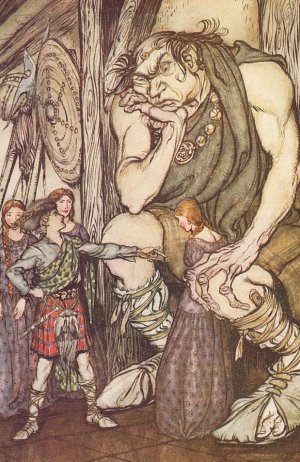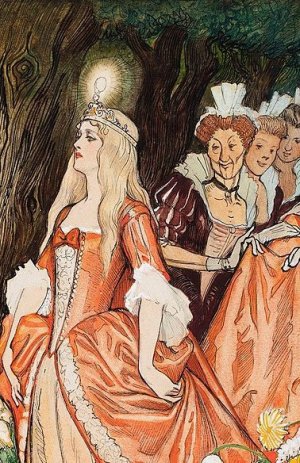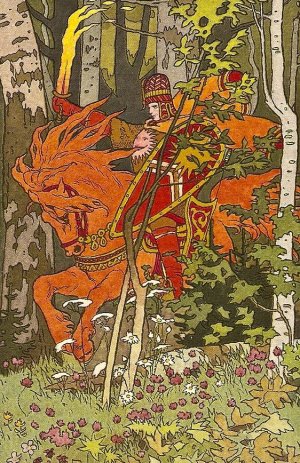| Library / Literary Works |
The Curly-Tailed Lion
Once upon a time, some Dutch hunters went to Africa, hoping to capture a whole family of lions. In this they succeeded. With a pack of hounds and plenty of aborigines to poke the jungle with sticks, they drove a big male lion, with his wife and four whelps, out of the undergrowth into a circle.
In the centre, they had dug a pit and covered it over with sticks and grass. Into this, the whole lion family tumbled. Then, by nets and ropes, the big, fierce creatures and the little cubs were lifted out. They were put in cages and brought to Holland. The baby lions, no bigger than pug dogs, were as pretty and harmless as kittens. The sailors delighted to play with them.
Now lions, even before one was ever seen among the Dutch, enjoyed a great reputation for strength, courage, dignity and power. It was believed that they had all the traits of character supposed to belong to kings, and which boys like to possess. Many fathers had named their sons Leo, which is Latin for lion. Dutch daddies had their baby boys christened with the name of Leeuw, which is their word for the king of beasts.
Before lions were brought from the hot countries into colder lands, the bear and wolf were most admired; because, besides possessing plenty of fur, as well as great claws and terrible teeth, they had great courage. For these reasons, many royal and common folks had taken the wolf and bear as namesakes for their hopeful sons.
But the male lion could make more noise than wolves, for he could roar, while they could only howl. He had a shaggy mane and a very long tail. This had a nail at the end, for scratching and combing out his hair, when tangled up. If he were angry, the mighty brute could stick out his red tongue, curled like a pump handle, and nearly half a yard long.
So the lion was called the king of beasts, and the crowned rulers and knights took him as their emblem. They had pictures of the huge creature painted on their flags, shields and armor. Sometimes they stuck a gold or brass lion on their iron war hats, which they called helmets. No knight was allowed to have more than one lion on his shield, but kings might have three or four, or even a whole menagerie of meat-eating creatures. These painted or sculptured lions were in all sorts of action, running, walking, standing up and looking behind or before.
Now there was a Dutch artist, who noticed what funny fellows kings were, and how they liked to have all sorts of beasts and birds of prey, and sea creatures that devour, on their banners. There were dragons, two-headed eagles, boars with tusks, serpents with fangs, hawks, griffins, wyverns, lions, dragons and dragon-lions, besides horses with wings, mermaids with scaly tails, and even night mares that went flying through the dark. With such a funny variety of beast, bird, and fish, some wondered why there were not cows with two tails, cats with two noses, rams with four horns, and creatures that were half veal and half mutton. He noticed that kings did not care much for tame, quiet, peaceable, or useful creatures, such as oxen or horses, doves or sheep; but only for those brutes that hunt and kill the more defenceless creatures.
Since, then, kings of the country must have a lion, the artist resolved to make a new one. He would have some fun, at any rate.
So as painter or sculptor select men and women to pose for them in their study as their heroes and heroines, and just as they picture plump little boys and girls as cherubs and angels, so the Dutchman would make of the cubs and the father beast of prey his models for coats of arms.
Poor lions! They did not know, but they soon found out how tiresome it was to pose. They must hold their paws up, down, sideways or behind, according as they were told. They must stand or kneel, for a long time, in awkward positions. They must stick out their tongues to full length, walk on their hind legs, twist their necks, to one side or the other, look forward or backward, and in many tiresome ways do just as they were ordered. They must also make of their tails every sort of use, whether to wrap around posts or bundles, to stick out of their cage, or put between their legs, as they ran away, or to whisk them around, as they roared; or hoist them up high when rampant.
In some cases, they were expected, even, to put on spectacles, and pretend to be reading, to hold in their paws books and scrolls, or town arms, or shop signs. They must pose, not only as companions of Daniel, in the lions' den at Babylon, which was proper; but also to sit, as companion of St. Mark, and even to stand on their legs on the top of a high column, without falling off.
In a word, this artist belonged to the college of heralds, and he introduced the king of beasts into Dutch heraldry.
So from that day forth, the life of that family of African lions, from the daddy to the youngest cub, was made a burden. When at home in the jungle and even in the cage, the father lion's favorite position was that of lolling on one side, with his paws stretched out, and half asleep and all day, until he went out, towards dark, to hunt. Now, he must stand up, nearly all day. Daddy lion had to do most of the posing, until the poor beast's front legs and paws were weary with standing so long.
Moreover, the hair was all worn off his body at the place where he had to sit on the hard wooden floor. He must do all this, on penalty of being punched with a red hot poker, if he refused. A charcoal furnace and long andirons were kept near by, and these were attended to by a Dutch boy. Or, it might be that the whole family of lions were not allowed to have any dinner till Daddy obeyed and did what he was told, though often with a snarl or a roar.
First, Leo must rise upon his hind legs and look in front of him. This posture was not hard, for in his native jungle, he had often thus obtained a breakfast of venison for his wife and family. But oh, to stand a half hour on two legs only, when he had four, and would gladly have used all of them, was hard. Yet this was the position, called "the lion rampant," which kings liked best.
But the king's uncles, nephews, nieces, cousins, and his wife's relations generally, every one of them, wanted a lion on his or her stationery and pocket handkerchiefs, as well as on their shields and flags. So the old lion was tortured - the hot poker being always in sight - and he was made to take a great variety of positions. The artist called out to Leo, just as a driver says to his cart horse, "whoa," "get up," "golong," etc. When he yelled in this fashion, the lion had to obey.
Pretty soon lions in heraldry, on flags, armor, town arms, family crests and city seals became all the fashion. The whole country went lion-mad. There were lions carved in stone, wood and iron, and every sort and kind, possible or impossible. Some of them seemed to be engaged in a variety of tricks, as if they belonged to a circus, or were having a holiday. They laughed, giggled, yawned, stuck out their tongues, held boards for hotels, bundles for the shopkeepers, or barrels for beer halls, and made excellent shop signs, which the boys and girls enjoyed looking at.
Mrs. Leo was not in much demand, for Mr. Leo did not approve of his wife's appearing in public. She was kept busy in taking care of her cubs. Daddy Lion had to do multiple work for his family, until the cubs were grown. Yet long before this time had come, their Dad had died and been stuffed for a museum. How this first king of beasts in the Netherlands came to his untimely end was on this wise.
Not satisfied with posing Leo in every posture, and with all possible gestures, his master, the artist, wanted him to look "heraldical"; that is, like some of the mythical beasts that were combinations of any and all creatures having fins, fur, feathers, or scales, such as the dragon or griffin.
One day, he attempted to make out of a live lion a fanciful creature of curlicues and curliewurlies. So he strapped the lion down, and used a curling iron on his mane until he looked like a bearded bull of Babylon. Then he combed out, and, with curl papers, twisted the long line of hair, which is seen in front of Leo's stomach. In like manner, he treated the bunches of hair that grow over the animal's kneepans and elbows.
Last of all, he took a hair brush, and smoothed out the tuft, at the end of the animal's long tail. Then the artist made a picture of him in this condition, all curled and rich in ringlets, like a dandy.
By this time, the father of the lion family looked as if he had come out fresh from a hairdresser's parlor. Indeed, Mrs. Leo was so struck with her husband's appearance, that she immediately licked her cubs all over, until their fur shone, so they should look like their father. Then, having used her tongue as a comb, to make her own skin smooth and glossy, she completed the job by using the nail in her tail, to do the finishing work. Altogether, this was the curliest family of lions ever seen, and Daddy Leo appeared to be the funniest curly-headed and curly-bodied lion ever seen. In fact he was all curls, from head to tail.
Notwithstanding all his pains, the artist was not yet satisfied with his job. He wanted a circle of long hair to grow in the middle of the lion's tail. His curly lion should beat all creation, and in this way he proceeded.
His own daughter, being a young lady and having some trouble of the throat, the doctor had ordered medicine for the girl, charging her not to spill any drops of the liquid on her face, or clothes.
But, in giving the dose, either the mother, or the daughter, was careless. At that very moment the cat ran across the room, after the mouse, and just as she held the spoon to her mouth, Puss got twisted in her skirts. So most of the medicine splashed upon her upper lip and then ran down to her chin, on either side of her mouth. She laughed over the spill, wiped off the liquid, and thought no more of the matter.
But a week later, she was astonished. On waking, she looked in the glass, only to shrink back in horror. On her face had grown both moustaches and a beard. True, both were rather downy, but still they were black; and, until the barber came, and shaved off the growth, she was a bearded woman. Yet, strange to tell, after one or two shaves by the barber, no more hair grew again on her face, which was smooth again.
"By Saint Servatus! I'll make a fortune on this," cried the artist, when he saw his daughter's hairy face.
So, he sold his secret to a druggist, and this man made an ointment, giving it a Chinese name, meaning "beard-grower." This wonderful medicine, as his sign declared, would "force the growth of luxuriant moustaches and a beard, on the smoothest face of any young man," who should buy and apply it.
Soon the whole town rang with the news of the wonderful discovery. The druggist sold out his stock, in two days, to happy purchasers. Other young fellows, that wanted to outrival their companions, had to wait a fortnight for the new medicine to be made. By that time, a full crop of downy hair had come out on the cheeks and chin and upper lip of many a youth. Some, who had been trying for years to raise moustaches, in order duly to impress the girls, to whom they were making love, were now jubilant. In several cases, a lover was able to cut out his rival and win the maid he wanted. Several courtings were hastened and became genuine matches, because a face, long very smooth, and like a desert as to hair, bore a promising crop. Beard and cheeks had at last met together. So the new medicine was called a "match-maker."
The artist rubbed his hands in glee, at the prospect of a fortune. He argued that if the wonderful ointment made beards for men, it must be good for lions also. So again, Daddy Lion was coerced by the threat of the hot poker. Then his tail was seized, and, by means of a rope, tied to a post on one side of the cage, he was held fast. Then the artist anointed about six inches of the middle of the smooth tail with the magic liquid. For fear the lion might lick it off, the poor beast was held in this tiresome position for a whole week, so that he could not turn round, and he nearly died of fatigue.
But it happened to the lion's tail, as it did with the young men's chins, cheeks and upper lips. A beard did indeed grow, but once shaved off - and many did shave, thinking to promote greater growth - no more hair ever appeared again. The ointment forced a downy growth but it killed the roots of the hair.
A worse fate befell the lion. A crop of hair, perhaps an inch longer than common, grew out. But this time, the bad medicine, which had deceived men, and was unfit for lions, struck in.
From this cause, added to nervous prostration, old Leo fell dead. As lion fathers go, he was a good one, and his widow and children mourned for him. He had never once, however hungry, tried to eat up his cubs, which was something in his favor.
Soon after these exploits, the old artist died also. His son, hearing there was still a demand, among kings, for lions, and those especially with centre curls in their tails, took the most promising of the whelps and petted and fed him well. In the seventh year, when his mane and elbow and knee hair had grown out, this cub was mated to a young lioness of like promise.
When, of this couple, a male whelp was born, it was found that in due time its knees, elbows, tail-tuft, and the front of its body were all rich in furry growth. In the middle of its tail, also, thick ringlets, several inches long, were growing.
Evidently, the hair tonic had done some good. So this one became the father of all the curly-tailed lions in the Netherlands. Not only was this lion, thus distinguished for so novel an ornament, copied into heraldry, but it adorned many city seals and town arms. In time, the lion of the Netherlands was pictured with a crown on its head, a sword in its right hand, a bundle of seven arrows - in token of a union of seven states - and, still later, the new Order of the Netherlands Lion was founded. The original curly lion, with long hair in the middle of its tail, boasts of a long line of descendants that are proud of their ancestor.
Source: Dutch Fairy Tales for Young Folks by William Elliot Griffis



